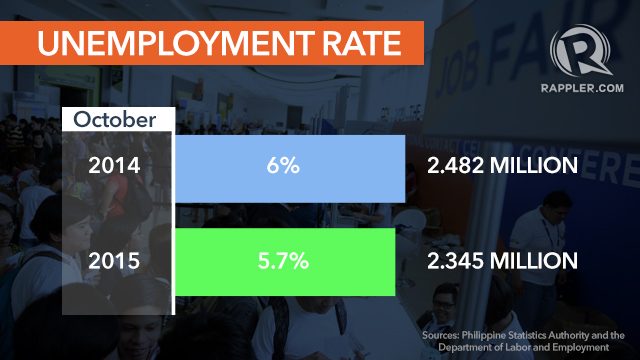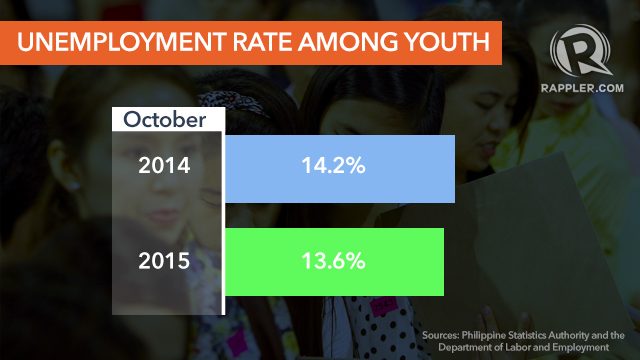SUMMARY
This is AI generated summarization, which may have errors. For context, always refer to the full article.

MANILA, Philippines – More jobs in the services and industry sectors in October 2015 led to a decline in the country’s unemployment rate for the period, government data showed.
The latest Labor Force Survey (LFS), released by the Philippine Statistics Authority on Thursday, December 10, said the country’s unemployment rate went down from 6% or 2.482 million in October 2014 to 5.7% or 2.345 million in October of this year.

According to Presidential Spokesperson Edwin Lacierda, the figure is the lowest recorded unemployment rate in the past 10 years. (READ: PH unemployment rate eases to 6.4% in April)
“Coupled with an improvement in employment and a decrease in underemployment, this serves as an indication of our economy’s robust growth,” he said in a statement Thursday.
It is important to note, however, that the October 2015 LFS does not include data from Leyte province, which was heavily damaged by Super Typhoon Yolanda (international name: Haiyan) in 2013.
Last year’s LFS did not include data from the said province as well.
Employment rate among Filipinos rose to 94.3% from 94% last year, while underemployment decreased to 17.6% compared to last year’s 18.7%.


“In this particular survey round, the net increase in the number of employed persons (+163,000) is marked by quality employment, as shown by the number of employed persons working full time, or those who worked 40 hours or more, reaching 25.892 million, or an increase of 691,000 over the 24.720 million posted in the 2014 October LFS round,” said Labor Secretary Rosalinda Baldoz.
The services and industry sectors contributed the most to the employment rate increase by hiring 440,000 and 169,000 more employees in the past year, respectively.
Baldoz said these figures “offset the losses of 446,000 recorded in agriculture, obviously on account of the El Nino phenomenon.”
More wage and salary workers were recorded in October 2015 as well, with 23.127 million employees compared to last year’s 22.554 million.

“Conversely, those who are self-employed without any paid employee declined by 123,000, while those who worked without pay in own family-operated businesses—the so-called unpaid family workers—also decreased by 385,000, from 4.171 million in the 2014 October LFS round to 3.786 million in the current survey round,” said Baldoz.
Unemployment among the Filipino youth aged 15 to 24 years old decreased as well, from 14.2% last year to 13.6% this year.

Economic Planning Secretary Arsenio Balisacan noted that the labor force participation rate dipped to 63.4%, mainly coming from the young working age population.
“The decision among the 15- to 24-year old population not to look for work during the period could be because they chose to pursue higher education or undergo training, as indicated by the increase in tertiary education enrollment rate, as well as the increase in technical vocational engagements among the youth,” said Balisacan.
Work harder
Baldoz said that the latest LFS results show that the government “has achieved concrete gains in decent work.”
“I welcome the positive result of the 2015 October round of the Labor Force Survey, with a pledge on behalf of the Department of Labor and Employment to press harder forward in the next six months with our reform programs and services that I believe have contributed—and continues to contribute—positively to the national goal of employment generation and poverty reduction towards inclusive growth,” she said.
For Balisacan, these gains in the labor sector will continue if the government continues to focus on providing quality employment for Filipinos.
“We need to sustain public investments in education and training to improve labor productivity and capacities. At the same time, we need to sustain the momentum of fiscal spending, particularly in infrastructure development, to boost economic growth and employment in agriculture and industry sectors,” he said.
While employment rate is steadily increasing under Aquino’s term, labor groups have criticized him for his failure to address other labor concerns, including widespread contractualization, companies’ compliance with labor laws, and an increase in the minimum wage. – Rappler.com
Add a comment
How does this make you feel?
There are no comments yet. Add your comment to start the conversation.